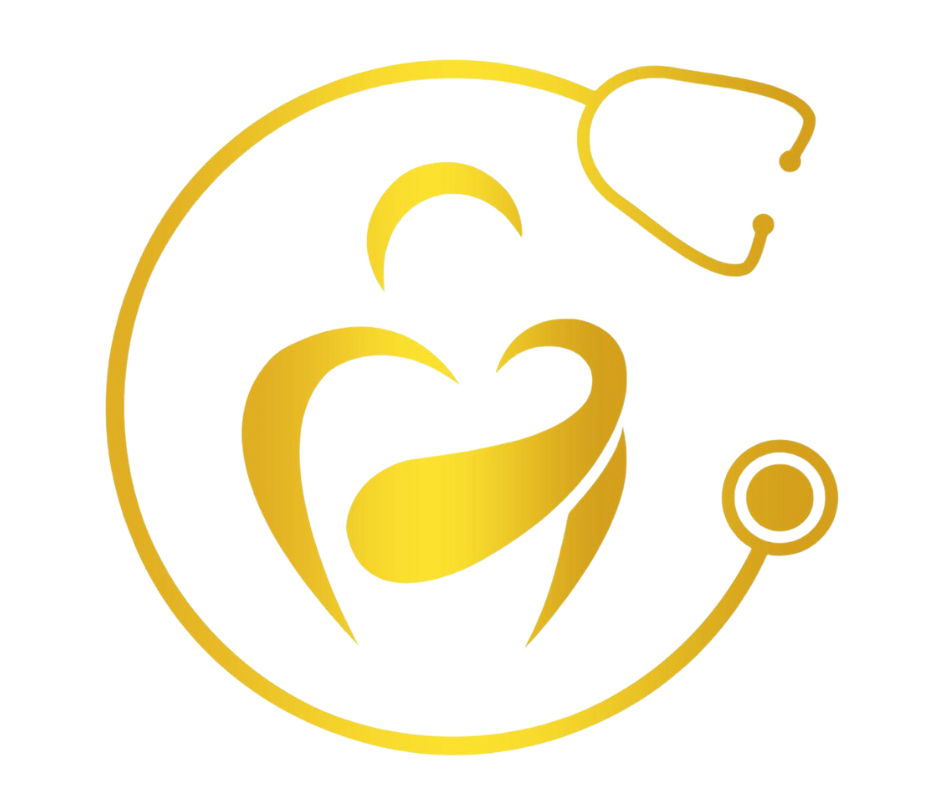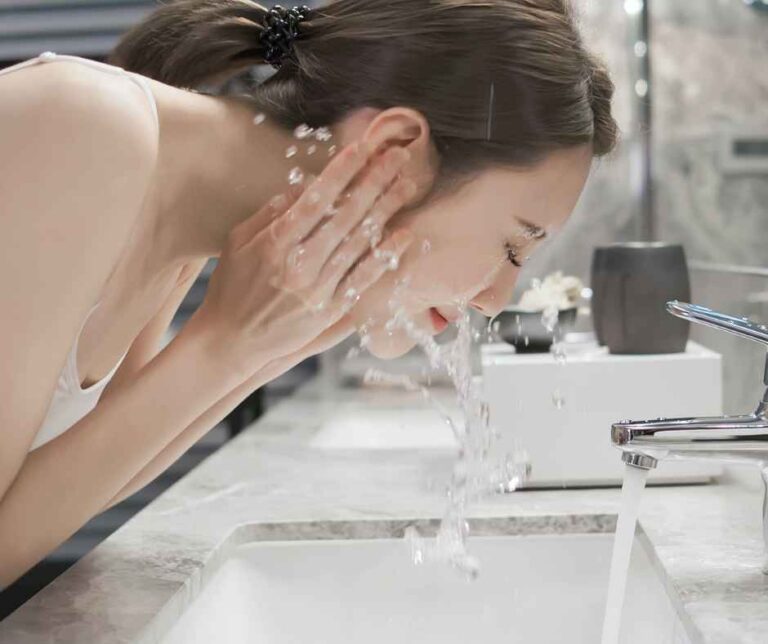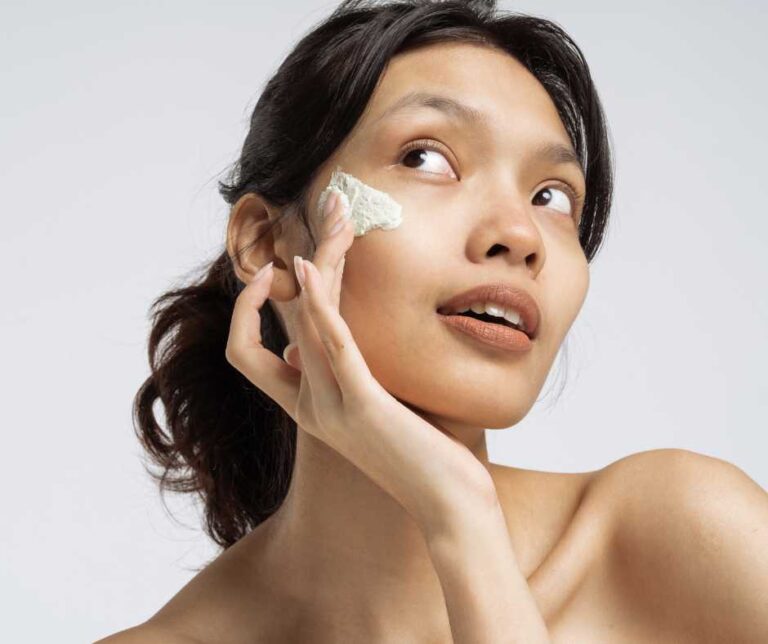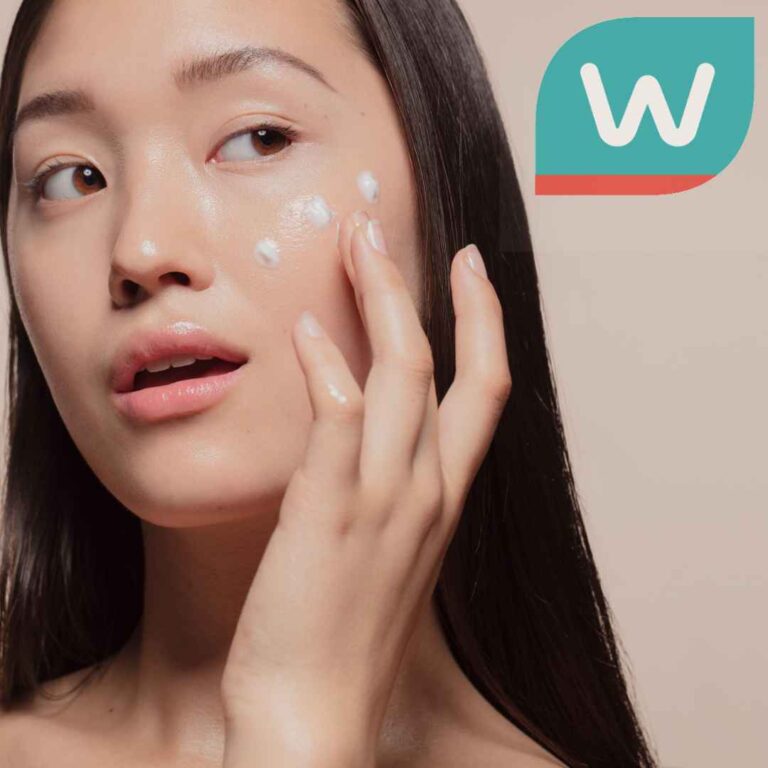Are you concerned about what’s really in your beauty products? Are you a person who is also health-conscious?
You’re not alone.
With the growing awareness of ingredient safety and environmental impact, more of us are turning to clean beauty than ever before.
As an aesthetic doctor, as well as an obstetrician, I find it important to find that right balance where beauty meets wellness.
We all desire to look and feel confident, but at the same time, it is important to maintain the foundation of our health.
In this comprehensive guide, we’ll walk you through everything you need to know about making the switch to clean beauty products or even if you’re starting to use makeup as a beginner, while still being super effective for your look and your health!
What is Clean Beauty?

Clean beauty isn’t just another trending hashtag – it’s a movement towards safer, more transparent beauty products. At its core, clean beauty represents products formulated without harmful ingredients that could potentially impact your health or the environment.
“Clean beauty is about creating effective products using safe, non-toxic ingredients while maintaining complete transparency with consumers,” explains Dr. Sarah Chen, board-certified dermatologist and clean beauty advocate.
Why This Guide Matters
The global clean beauty market is expected to reach $22 billion by 2024, growing at an unprecedented rate of 12% annually. This surge reflects a fundamental shift in how we think about our beauty products. Whether you’re a skincare enthusiast or a makeup beginner, understanding clean beauty is becoming increasingly essential for making informed choices about what you put on your skin.
Understanding Clean Beauty: Beyond the Basics
What Makes Beauty Products “Clean”?
Clean beauty products typically meet these criteria:
- Free from harmful ingredients
- Transparently labeled
- Ethically produced
- Environmentally conscious
- Third-party certified (when applicable)
Industry Standards and Certifications

Popular clean beauty certifications include:
- COSMOS
- USDA Organic
- EWG Verified
- Leaping Bunny
- Made Safe
Why Make the Switch to Clean Beauty?
Health Considerations
Research suggests that the average person applies 168 different chemicals to their body through personal care products daily. Many conventional products contain ingredients linked to various health concerns, from simple skin irritation to more serious issues.
Daily, we use makeup, lotions, deodorants, shampoo, and soaps on our bodies without realizing the harmful ingredients and chemicals they contain.
Clean beauty products are free from artificial colours, fragrances, parabens, and sulfates. By making an effort to use these products, it is an excellent way to start taking better care of our bodies by using products that are non-toxic, gentle, and free of harsh chemicals.
Environmental Impact
Clean beauty brands typically prioritize:
- Sustainable sourcing
- Eco-friendly packaging
- Reduced water waste
- Lower carbon footprint
The Toxic Truth: Ingredients to Avoid
Major Red-Flag Ingredients
Parabens
- Common names: methylparaben, propylparaben, butylparaben
- Why avoid: Potential hormone disruption
- Where found: Moisturizers, shampoos, foundations
It is commonly used to extend shelf life by preventing the growth of bacteria and mold. It may disrupt the endocrine system, cause reproductive harm and cause contact allergy. Parabens increases the risk of breast cancer, skin cancer, and decreased sperm count.
Look for ingredients that are marked “paraben-free”.
Phthalates
- Common names: DBP, DEHP, DEP
- Why avoid: Reproductive concerns
- Where found: Fragrances, nail polishes
Phthalates are commonly found in fragranced lotions, body washes, nail polish and hair care products. They are chemicals linked to developmental and reproductive toxicity and cancer; as well as, cause contact allergies.
Look for products that are fragrance-free and that do not contain Di-n-butyl Phthalate (DBP) to prevent exposure to phthalates.
Synthetic Fragrances
- Common names: Acetaldehyde, Benzophenone, Benzyl Salicylate, Diethyl phthalate
- Why avoid: Kidney problems
- Where found: Fragrances
Often products list “fragrance” on the label or list of ingredients but do not name the specific ingredients that make up the fragrance. These specific ingredients affect the kidneys, can cause contact allergies, affect reproductive and respiratory systems, cause endocrine disruption, and can cause cancer.
Look for products that are “fragrance-free” and especially those who do not list the specific ingredients when listing “fragrance”.
Other toxic ingredients you should avoid:
- Hydroquinone
- Sulfates
- p-Phenylenediamine
- Phenoxyethanol
- Sodium laureth sulfate
- Octinoxate
- Oxybenzone
- Triethanolamine
Essential Clean Beauty Ingredients

Natural Alternatives That Work
Plant-Based Preservatives
- Radish root ferment filtrate
- Honeysuckle extract
- Leuconostoc ferment
Effective Natural Actives
- Bakuchiol (retinol alternative)
- Vitamin C from Kakadu plum
- Niacinamide from rice
Building Your Clean Beauty Routine

Creating an effective clean beauty routine doesn’t have to be complicated. Let’s break down each essential step and learn how to choose the right products for your skin.
Essential Skincare Steps for Healthy Skin
1. Cleansing: The Foundation of Clean Skincare
Why Proper Cleansing Matters
Cleansing removes dirt, excess oil, and environmental pollutants while preparing your skin for the products that follow. The right cleanser should clean effectively without stripping your skin’s natural barrier.
What to Look For in Clean Cleansers
Gentle Surfactants
- Coco glucoside: Plant-derived, gentle yet effective
- Decyl glucoside: Mild, suitable for sensitive skin
- Saponified oils: Natural soap alternatives
- Yucca extract: Natural foaming agent
Balanced pH Levels
- Ideal pH range: 4.5-5.5
- Why it matters: Maintains skin’s acid mantle
- Benefits: Prevents bacterial growth and maintains healthy barrier function
Natural Fragrance Options
- Essential oils (in small amounts)
- Herb extracts
- Flower waters
- Unscented options
Recommended Cleansing Techniques
- Morning Cleanse
- Gentle, water-based cleanser
- Lukewarm water
- 30-60 seconds of massage
- Evening Double Cleanse
- First cleanse: Oil-based cleanser
- Second cleanse: Water-based cleanser
- Focus on removing sunscreen and makeup
Signs of a Good Cleanser
- Skin feels clean but not tight
- No residue
- No redness or irritation
- Maintains natural moisture
2. Toning: Balancing and Preparing the Skin
The Role of Toners
Modern clean toners serve multiple purposes:
- Balance skin pH
- Add hydration
- Prepare skin for following products
- Deliver gentle active ingredients
Key Ingredients to Look For
Alcohol-Free Formulas
Instead of drying alcohols, look for:
- Witch hazel (alcohol-free)
- Aloe vera juice
- Rose water
- Chamomile hydrosol
Natural Hydrators
- Glycerin: Plant-derived humectant
- Hyaluronic acid: Natural moisture binding
- Beta glucan: Derived from mushrooms
- Panthenol: Vitamin B5 derivative
Soothing Botanicals
- Centella asiatica (gotu kola)
- Green tea extract
- Calendula
- Licorice root
Application Methods
Traditional Application
- Pour toner onto cotton pad
- Gently sweep across face
- Allow to absorb for 30 seconds
Patting Method (Korean Beauty Inspired)
- Pour toner into palms
- Press gently into skin
- Layer 2-3 times for extra hydration
Mist Application
- Choose a fine mist bottle
- Spray 2-3 pumps onto face
- Can be used throughout day
Special Considerations
For Dry Skin
- Look for extra hydrating ingredients
- Consider layering technique
- Avoid astringent botanicals
For Oily Skin
- Choose lighter formulations
- Look for balancing ingredients
- Consider using as spot treatment
For Sensitive Skin
- Minimal ingredient list
- Fragrance-free options
- Patch test new products
Signs of a Good Toner
- No stinging or burning
- Leaves skin feeling refreshed
- Improves product absorption
- Doesn’t cause breakouts
Pro Tips for Building Your Routine
Timing Matters
- Wait 30 seconds between steps
- Apply products while skin is slightly damp
- Total routine should take 3-5 minutes
Product Compatibility
- Start with one new product at a time
- Allow 2 weeks between introducing products
- Keep track of reactions and results
Seasonal Adjustments
- Lighter products in summer
- More hydration in winter
- Adjust cleansing intensity based on activity level
Common Mistakes to Avoid
- Over-cleansing
- Skipping toner
- Using too many products
- Rushing between steps
- Not patch testing
When to Seek Professional Help
- Persistent irritation
- Unusual reactions
- No improvement after 8-12 weeks
- Specific skin concerns
Remember: Building a clean beauty routine is personal, and what works for others may not work for you. Listen to your skin, make adjustments as needed, and be patient as you find your perfect combination of products.
Making the Switch to Clean Beauty: Your Complete Transition Plan

Transitioning to clean beauty doesn’t have to be overwhelming. This comprehensive guide will walk you through each step of the process, ensuring a smooth and successful switch to clean beauty products.
Step 1: Audit Current Products
Creating Your Product Inventory
Start by gathering all your beauty and personal care products in one place. Create a detailed spreadsheet or use our downloadable inventory template to track:
Essential Information to Record
- Product name and brand
- Category (skincare, makeup, body care)
- Purchase date
- Expiration date
- Daily/weekly usage frequency
- Current amount remaining
- Approximate replacement date
- Price point
- Your satisfaction rating (1-5)
Checking Ingredients Lists
How to Analyze Your Products
- Download a clean beauty app (Think Dirty, EWG Healthy Living)
- Photograph or input product ingredients
- Note hazard ratings for each product
- Flag products containing:
- Parabens
- Phthalates
- Synthetic fragrances
- Formaldehyde donors
- Other harmful ingredients
Expiration Assessment
Check for Signs of Expiration
- Changed color or texture
- Unusual smell
- Separation of ingredients
- Reduced effectiveness
- Past printed expiration date
Product Shelf Life Guidelines
- Mascara: 3-6 months
- Liquid foundation: 6-12 months
- Powder products: 18-24 months
- Lipstick: 12-18 months
- Skincare: 6-12 months after opening
Step 2: Prioritize Your Transitions
High-Priority Replacements
- Products that:
- Are expired
- Cause irritation
- Contain known harmful ingredients
- Stay on skin longest (moisturizer, foundation)
- Cover large body areas
- Daily-use items:
- Facial cleanser
- Moisturizer
- Sunscreen
- Body lotion
- Deodorant
Medium-Priority Replacements
- Makeup products
- Treatment products
- Hair care items
- Body wash
- Hand cream
Low-Priority Replacements
- Occasional use products
- Special occasion items
- Backup products
- Travel sizes
Step 3: Research Clean Alternatives
Finding Clean Replacements
Research Methods
- Online Resources
- Clean beauty blogs
- Expert reviews
- Scientific studies
- Brand websites
- In-Store Research
- Clean beauty retailers
- Ingredient consultation
- Sample testing
- Staff recommendations
Evaluation Criteria
- Ingredient safety
- Brand transparency
- Price point
- User reviews
- Environmental impact
- Packaging sustainability
Step 4: Implementation Strategy
The 90-Day Transition Plan
Month 1: Foundation
- Replace highest priority items
- Begin ingredient education
- Start patch testing new products
- Document skin reactions
Month 2: Building
- Replace medium-priority items
- Refine skincare routine
- Adjust based on results
- Add treatment products
Month 3: Completion
- Replace remaining items
- Fine-tune product combination
- Establish maintenance routine
- Plan future purchases
Budget Management
Cost-Saving Strategies
- Gradual Replacement
- Replace as products run out
- Watch for sales
- Buy starter kits
- Use sample sizes first
- Strategic Shopping
- Subscribe to brand newsletters
- Join loyalty programs
- Buy during seasonal sales
- Look for bundle deals
Step 5: Monitoring and Adjustment
Tracking Your Progress
Keep a Beauty Journal
- Daily skin observations
- Product reactions
- Combination effects
- Environmental factors
- Stress levels
- Diet changes
Success Metrics
- Skin improvement
- Reduced sensitivity
- Better product performance
- Environmental impact
- Cost effectiveness
Making Adjustments
When to Adjust Your Plan
- Negative skin reactions
- Budget constraints
- Seasonal changes
- New skin concerns
- Product availability
How to Make Changes
- Identify the issue
- Research alternatives
- Make one change at a time
- Document results
- Adjust as needed
Tips for Success
Do’s
- Start slowly
- Patch test everything
- Keep original products as backup
- Document your journey
- Listen to your skin
Don’ts
- Replace everything at once
- Ignore skin reactions
- Rush the process
- Mix too many new products
- Exceed your budget
Create Your Personal Timeline
Weekly Goals Example
- Week 1: Complete audit
- Week 2: Research alternatives
- Week 3: Replace first product
- Week 4: Monitor results
Monthly Milestones
- Month 1: Basic routine established
- Month 2: Core products replaced
- Month 3: Full transition completed
- Month 4: Routine optimization
Support Resources
Tools and Apps
- Product tracking apps
- Ingredient checkers
- Budget planners
- Clean beauty databases
Community Support
- Clean beauty forums
- Social media groups
- Local clean beauty meetups
- Online workshops
Remember: Your clean beauty journey is personal. What works for others may not work for you. Stay patient, flexible, and focused on your goals as you make this important transition to safer, cleaner beauty products.
Expert Tips and Recommendations
“The key to a successful transition to clean beauty is taking it slow and listening to your skin,” advises Emma Roberts, clean beauty formulator and founder of Pure & Natural Beauty. “Start with replacing one product at a time and pay attention to how your skin responds.”
FAQs About Clean Beauty

Product Efficacy and Performance
Q: Will clean beauty products be as effective as conventional ones?
A: Modern clean beauty formulations can be just as effective as conventional products. Many natural ingredients have scientific backing for their efficacy. For example, bakuchiol has been proven in clinical studies to provide retinol-like benefits, while niacinamide from natural sources shows the same skin-brightening effects as its synthetic counterpart.
Q: Do clean beauty products have a shorter shelf life?
A: While clean products may have slightly shorter shelf lives due to natural preservatives, most well-formulated products last 6-12 months after opening. Many brands now use innovative natural preservation systems that maintain stability without compromising safety.
Q: How long should I wait to see results from clean beauty products?
A: As with any skincare product, expect to wait 4-8 weeks to see significant results. Some products, like cleansers and moisturizers, will show immediate effects, while treatment products targeting specific concerns may take longer.
Cost and Value
Q: Why are clean beauty products often more expensive?
A: Clean beauty products often cost more because:
- Higher quality natural ingredients
- Sustainable sourcing practices
- Small-batch production
- More expensive preservation systems
- Ethical manufacturing processes However, many affordable clean beauty brands are now entering the market.
Q: Are luxury clean beauty products worth the investment?
A: The value depends on your priorities and budget. While luxury products often contain higher concentrations of active ingredients and unique formulations, many mid-range clean beauty products can provide excellent results.
Safety and Ingredients
Q: Are all natural ingredients safe for skin?
A: Not necessarily. Natural doesn’t always mean safe or gentle. Some natural ingredients like essential oils can cause irritation. It’s important to patch test and research ingredients, regardless of their source.
Q: Can I be allergic to clean beauty products?
A: Yes, allergies can occur with any ingredient, natural or synthetic. Common natural allergens include:
- Essential oils
- Plant extracts
- Natural fragrances
- Nut oils Always patch test new products.
Q: Are preservatives in clean beauty products safe?
A: Clean beauty brands use natural preservatives that have been proven safe and effective, such as:
- Radish root ferment filtrate
- Honeysuckle extract
- Leuconostoc ferment These prevent bacterial growth while maintaining product safety.
Usage and Application
Q: Can I mix clean beauty products with conventional ones?
A: Yes, you can mix clean and conventional products. Focus on:
- Introducing new products gradually
- Monitoring skin reactions
- Ensuring ingredients don’t conflict
- Maintaining a balanced routine
Q: How should I store clean beauty products?
A: Store products:
- Away from direct sunlight
- In a cool, dry place
- With caps tightly sealed
- According to package instructions Some products may require refrigeration.
Transition and Results
Q: Will my skin purge when switching to clean beauty? A: Some people experience an adjustment period when switching to clean beauty. This may include:
- Temporary breakouts
- Changed skin texture
- Different product feel This typically resolves within 2-4 weeks.
Q: Can clean beauty products treat acne effectively? A: Yes, many clean ingredients effectively treat acne:
- Tea tree oil (antibacterial)
- Salicylic acid from willow bark
- Niacinamide
- Zinc oxide Choose products formulated specifically for acne-prone skin.
Environmental Impact
Q: Are all clean beauty products environmentally friendly?
A: While clean beauty brands often prioritize sustainability, check for:
- Recyclable packaging
- Sustainable sourcing
- Ethical manufacturing
- Cruelty-free certification
- Water conservation practices
Q: How can I verify if a product is truly “clean”?
A: Look for:
- Third-party certifications (EWG, COSMOS, USDA Organic)
- Transparent ingredient lists
- Clear company standards
- Manufacturing transparency
- Independent testing results
Special Concerns
Q: Are clean beauty products suitable for sensitive skin?
A: Many clean products work well for sensitive skin. Look for:
- Minimal ingredient lists
- Fragrance-free options
- Calming ingredients
- Hypoallergenic formulations Start with gentle, basic products.
Q: Can clean beauty products provide sun protection?
A: Yes, mineral sunscreens using zinc oxide and titanium dioxide provide effective UV protection. Ensure products are properly formulated and certified for sun protection.
Product Selection
Q: How do I choose the right clean beauty products for my skin type?
A: Consider:
- Your skin type and concerns
- Ingredient sensitivities
- Product reviews and recommendations
- Brand reputation
- Price point and availability
Q: What are the must-have clean beauty products for beginners?
A: Start with:
- Gentle cleanser
- Alcohol-free toner
- Daily moisturizer
- Mineral sunscreen
- Multi-purpose balm
Additional Resources
Still have questions? Consider:
- Consulting a clean beauty specialist
- Joining clean beauty communities
- Following clean beauty educators
- Reading scientific research
- Attending clean beauty workshops
Remember: Every person’s skin is unique, and what works for others may not work for you. Always patch test new products and listen to your skin’s needs.






